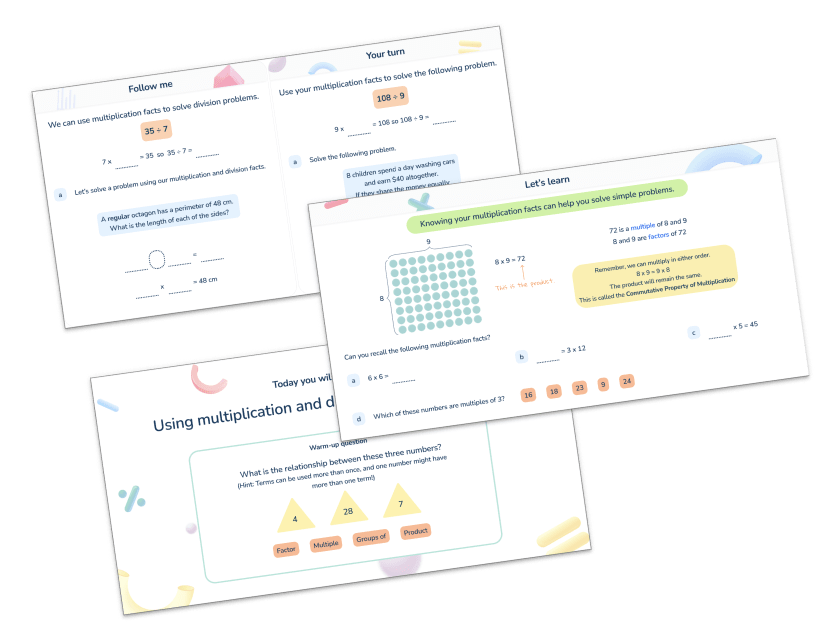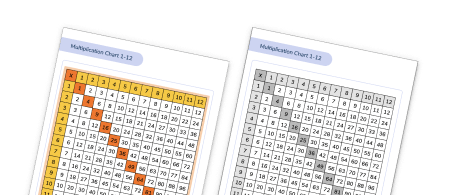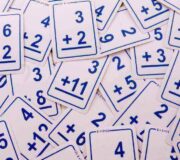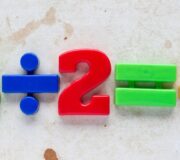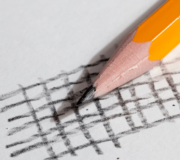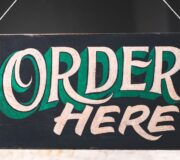How To Learn Multiplication Tables At Home: The Best Way To Master Your Multiplication Facts
We’ve written this guide specifically for parents of elementary aged children wondering how to help their child learn multiplication tables at home.
Multiplication tables, times tables, or multiplication facts, depending what your school calls them, can often prove problematic to young children to learn. However, once your child reaches 3rd grade it is almost exclusively the math homework most often proffered.
Children need to learn their multiplication tables in elementary school. There is no way of getting away from it. They are essential when learning many new math skills and concepts from the common core curriculum, such as fractions, decimals, factors, etc.
Multiplication does not show up in the math standards until 3rd grade, but students will gain foundations for multiplication in 2nd grade.
Not knowing your multiplication tables puts additional strain on your working memory when tackling such new concepts in math. This will hinder the transition of the new facts to the long term memory.
The simple truth is that if you don’t know your multiplication tables by middle school, then you’re starting at a severe disadvantage. The goal is instant recall, and to encourage children to achieve this by the end of 3rd grade.
Here at Third Space Learning, we have combined the knowledge of all the teachers behind our tutoring to explain how to learn multiplication tables, how they fit into multiplication at school, and how you can help your child with multiplication tables at home, regardless of their year group and age at elementary school.
Multiplication Chart 1-12
A multiplication chart showing the times tables from 1 – 12 to help children learn the times tables
Download Free Now!How to set the foundation for multiplication tables in 2nd grade
Here’s what you need to know to help your child succeed in gaining the foundations for multiplication in 2nd grade.
Your child doesn’t need to practice every multiplication table
You will be pleased to hear that at this age, your child only needs to work on their 2, 5 and 10 multiplication tables by practicing skip counting. Note that they will also need to know how to count by 100s.
Use play or objects to understand numbers
At this age, it is important that you don’t rush into teaching multiplication tables at home, and that you make sure that the key concepts behind the math used when working out multiplication tables is already in place.
One way to do this is to use real-world objects to help your child grasp the meaning of numbers and their values – after all, what’s the use of counting in 2s, 5s or 10s, if you don’t know what those numbers really represent?
Something as simple as getting all of their toy cars out at once, pairing them up and asking them to count out how many there are can be a great way to do this.
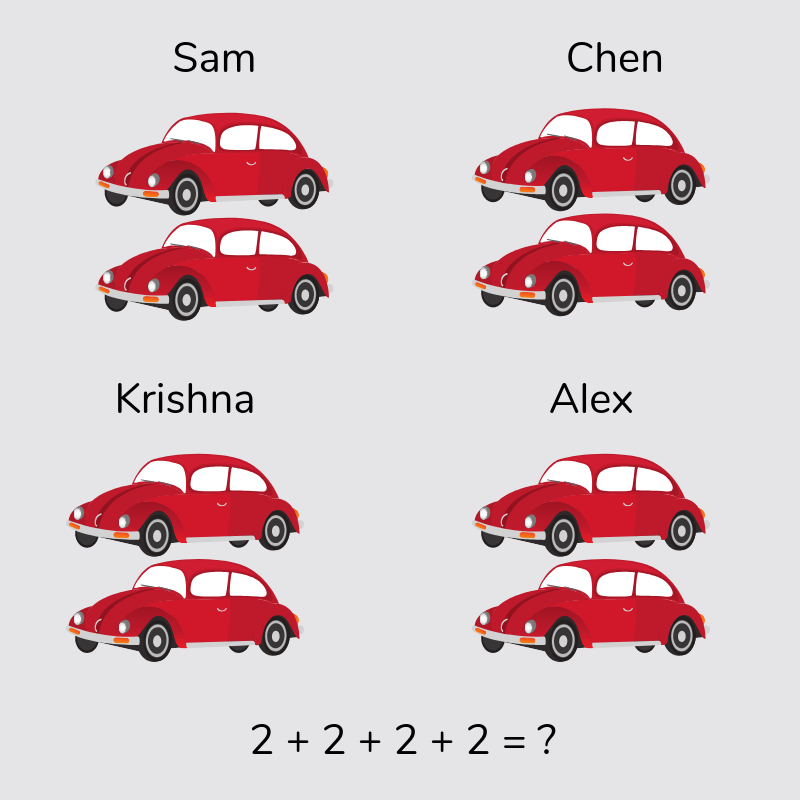
Real-life objects are also an excellent way to demonstrate the opposite (inverse) operation to multiplication which is division.
For example, if you have just done the clothes wash and have 20 socks that are ready to be put away, ask your child to divide them by two so that you know how many pairs you will need by the end of the process.
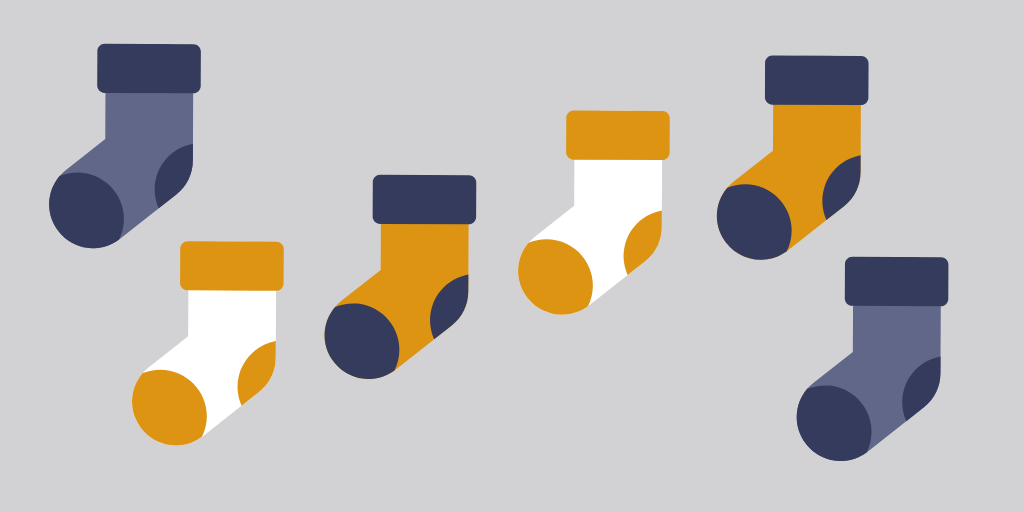
Bringing math into everyday activities around the home is a great way to answer the question of ‘how do I teach my child multiplication tables?’ – and let’s not forget that it’s also an effective method of getting the kids to help with putting away the laundry or tidying up the home!
There is no reason that knowing how to teach your child multiplication at home can’t help you with the chores too…

Meet Skye, the voice-based AI tutor making math success possible for every student.
Built by teachers and math experts, Skye uses the same pedagogy, curriculum and lesson structure as our traditional tutoring.
But, with more flexibility and a low cost, schools can scale online math tutoring to support every student who needs it.
Find out moreCounting in groups of 10 is one of the best ways to teach your child multiplication skills
10s are often the easiest multiplication table for children to grasp thanks to their simple pattern of ending in a 0, regardless of which other number they are multiplied by.
To begin, find some pictures with 10 objects in them and then ask your child how many there are altogether. You can work your way through the problem with them, counting all of the objects on the first round, and then helping them see that if there are 3 groups of 10 objects, they can bring their multiplication skills into the mix.
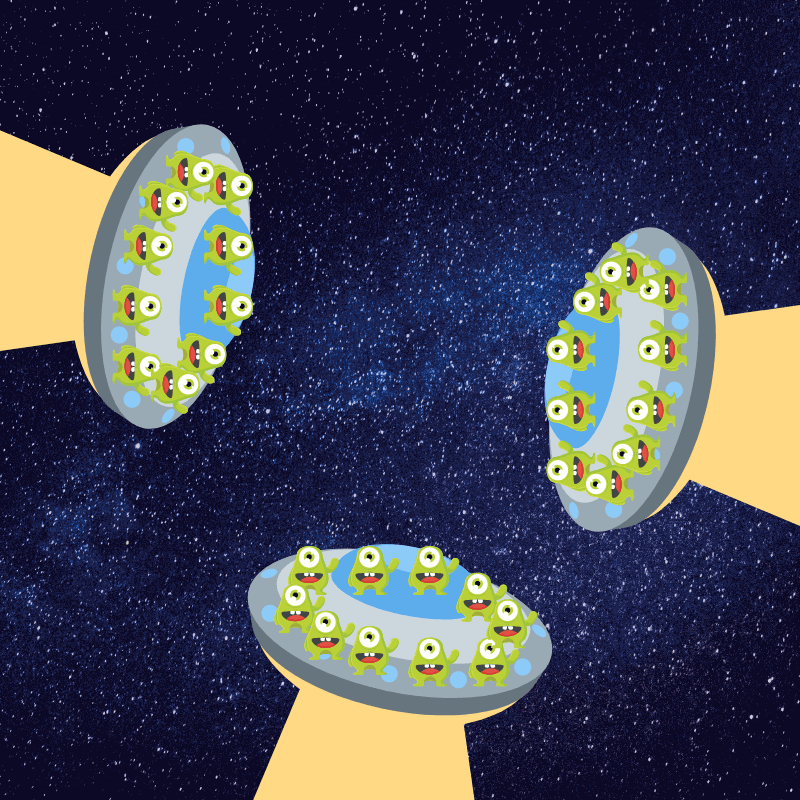
Number lines can help visualization when teaching your child about multiplication tables
If your child is struggling to understand the concept of counting by 10, a number line may help them to visualize the process.
You can use a number line to help them picture the jumps, or alternatively you could use a tape measure as a substitute in the likely scenario that you don’t have a number line at home.
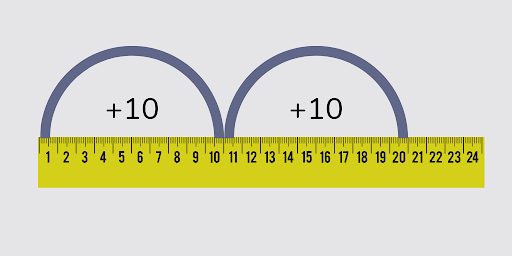
This is an easy way to teach a child multiplication tables, as by showing your 2nd grader how the 10s continue going up all the way along the number line, you can introduce the idea of 2 groups of 10 equaling 20, 3 groups of 10 equaling 30, and so on.
As with all new bits of math, a knowledge of place value is key before starting this.
Use the CRA (concrete-representational-abstract) approach to teach the concept of multiplication to your child
Often used in elementary schools, for those who haven’t heard of it, the CRA approach is simple.
Step 1 – Concrete: To begin, you should get a concrete example of the number you want to represent. An example could be 2 building blocks or 4 shoes.
Step 2 – Representational: The next step is to represent the concrete item from above in the form of a picture. This could be a bar chart, a tally chart or any other way of getting the information down onto a piece of paper in a visual format.
Step 3 – Abstract: The third and final step is to then represent the number in an abstract manner by writing it down in its numerical form.
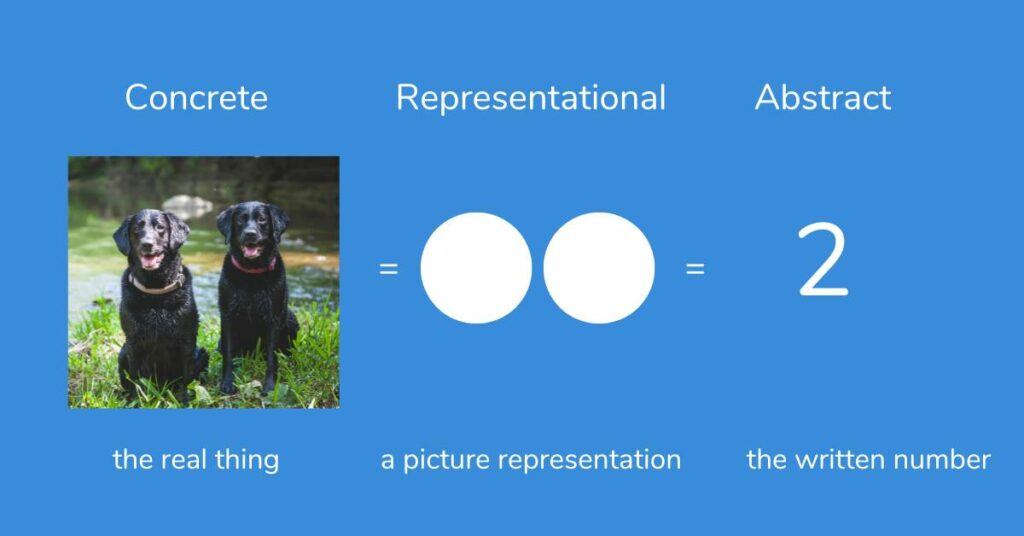
By bringing in the CRA approach to your decision of how to teach your child the concept of multiplication, you will find that it is a fantastic way to help a child visualize numbers and gain a deeper understanding of the numbers that are being discussed, which should help them in the long term.
This is also the reason why it is useful to have counters or blocks at hand any time you do math with young children!
Repeated addition can bridge the gap between adding up and multiplying
Repeated addition simply means adding a number to itself one or more times.
This will help your child get to the same result as a multiplication equation, but by using addition, which will probably be more familiar to them. You can then use this approach to help teach your child about their multiplication tables once they have grasped the concept.
So, for example:
2 x 3 written as repeated addition would be 2 + 2 + 2.
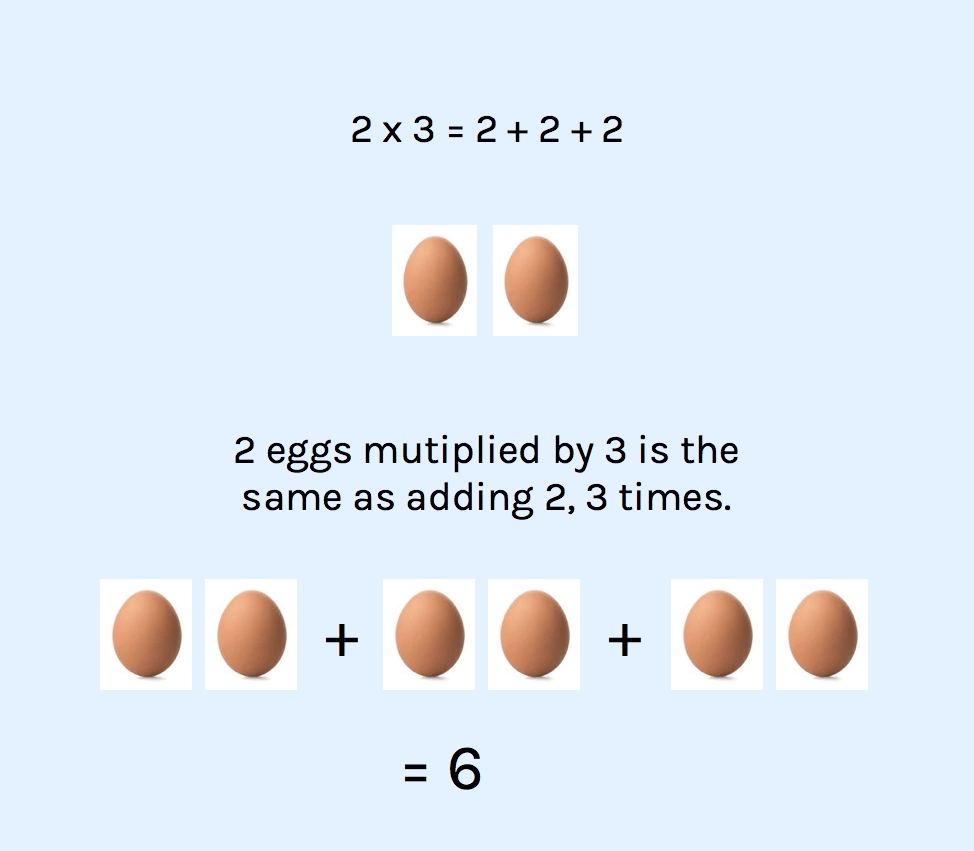
It’s a simple technique, but one that works well in the early stages of helping your child with multiplication tables at home. (You can also try repeated subtraction to model division but this can be a trickier concept to grasp.)
Arrays are a great way to bring multiplication tables to life on paper
Arrays are another visual method of representing multiplication or repeated addition.
You might recognize them from terms like ‘groups of’ and they’re really handy for investigating how multiplication is related to addition and division.

As you can see, this helps children to understand that multiplication involves more than one item.
Plus, it makes division much more accessible.
Try dividing 6 into equally sized groups once you’ve tried the arrays for 2 x 3!
How to learn multiplication tables at home: Fun ways to practice multiplication with 2nd graders
Multiplication tables at-home activity 1: Foodiplication
Use small food items like raisins and grapes to up the stakes when practicing grouping and arrays.
Counters can lose their novelty after a while, so spicing things up will certainly add to the fun!
Lay out a group of raisins (or whatever you prefer) and ask your child to group them into twos and threes before they eat them all.
This is a simple but effective way to encourage your child to think about the multiplication work they are doing, and they get the benefit of having an immediate tasty treat at the end!
Multiplication tables at-home activity 2: Silly number sentences
The best way to prepare for multiplication in number sentences is to say number sentences out loud so they get used to the vocabulary.
Read the following phrases out loud with your child and see if they can repeat them back to you. To ensure that your child is engaged with the game, get them to do a silly voice when they repeat each number sentence back to you.
An example game could look like:
Say 2 x 3 = 6 in a lion’s voice.
Say 6 ÷ 2 = 3 in grandad’s voice.
Say 6 ÷ 3 = 2 in your teacher’s voice.
Say 2 x 4 = 8 in your most silly voice.
Say 8 ÷ 4 = 2 in my voice!
Say 8 ÷ 2 = 4 in a dog’s voice.
How to learn multiplication tables in 3rd grade
If you have a child heading into 3rd grade, you’ll find that there is a lot going on just in the world of multiplication tables and learning multiplication!
By 3rd grade, your child should have a solid foundation for learning multiplication from the work they did with equal groups and skip counting in 2nd grade. They should also know how to arrange objects in an array and write a repeated addition sentence to represent it.
In 3rd grade, students will learn how to write multiplication sentences independently (e.g. 4 x 2 = 8). This is important as writing problems down will help them to keep track of their thinking and enable them to spot mistakes even if they have moved on to another part of the question.
3rd grade children need to understand the commutative property (don’t panic, we will cover this later) and begin to solve simple multiplication problems. As well as knowing their 2, 5 and 10 multiplication tables, they will benefit from understanding bar modeling, arrays, and grouping.
Top tip for 3rd grade multiplication: Regular multiplication tables practice makes multiplication in elementary school a much easier ride. Figure out how to help your child memorize multiplication tables and you have given them a fantastic headstart!
How you can help your child learn multiplication tables using a bar model
Bar modeling is a visual representation of math that is used in almost every elementary school.
It uses long rectangles (bars) to show how the method works, and they’re great for helping kids to understand what the numbers in math really mean.
Here’s an example of how you might use bar modeling to explain multiplication to your 3rd grader, based on the expression 2 x 3.
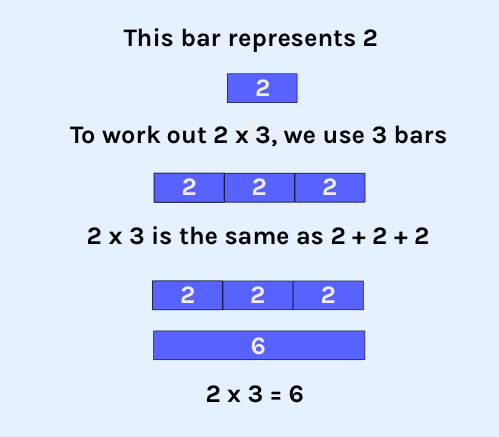
How you can help your child understand that multiplication is commutative
This may sound like a scary term, but we promise it’s not!
The commutative property says that changing the order of two numbers in an addition or multiplication equation does not change the sum or the product.
Take a look at the example below for a quick explanation:
We can switch the numbers we multiply around, and we’ll still get the same answer:
2 x 3 = 6
3 x 2 = 6
That’s because multiplication is commutative. (As is addition!)
If we try the same with division, it doesn’t work.
6 ÷ 2 = 3
2 ÷ 6 = 0.33333333333
They’re not the same answer, so division is not commutative. (Neither is subtraction!)
Once your child knows these rules, it will be a lot easier for them to see how multiplication and division work.
When helping your child with their multiplication tables at home, practice switching numbers around in the multiplication tables to show just how easy commutativity is.
Ask the following questions in pairs and ask your child what they notice:
2 x 1 = ?
1 x 2 = ?
2 x 3 = ?
3 x 2 = ?
5 x 2 = ?
2 x 5 = ?
Hopefully, your child will observe that while each of the equations looks slightly different, each pair gives the same answer.
How to help your child with multiplication problems at home
Often, 3rd graders can find it difficult determining which operation to use when solving a word problem, so a simple way you can help your child to learn multiplication at home is to point out words in the question that give you clues.
This question below has the word altogether. This tells us that the answer will be bigger than the numbers in the question. That means it must be addition or multiplication.
‘2 bags of 3 sweets’ tells us that we’re looking at ‘groups of.’
This kind of language is usually about multiplication.
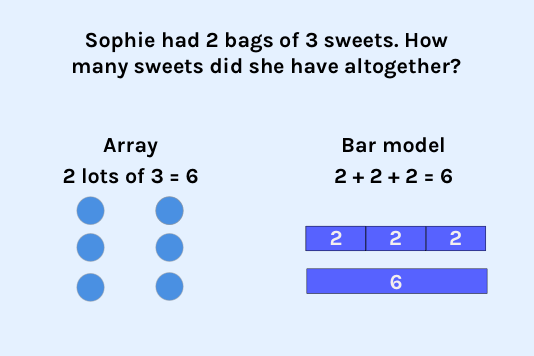
Make sure you spend some time with your child helping them to brush up on mathematical vocabulary often – studying vocabulary can make this kind of problem much easier!
If you know what the word ‘altogether’ means, you can hazard a good guess that the answer will be bigger than the two numbers in the question.
And that’s a huge step forward for understanding at this age!
A fun way to practice multiplication with 3rd graders – Using real-life math to master multiplication problems
Making up simple multiplication word problems on the go will help your child find them much easier to answer. Offering them the chance to sit at a table and answer questions versus heading out to help you with the shopping is only going to present one winner!
When you go shopping, ask questions that will get them thinking and give you a chance to demonstrate the answer (using concrete manipulatives if need be.)
- “If I buy 2 bags of 5 cookies, how many will there be altogether?”
- “How much will 3 bags that cost 5 dollars each cost altogether?”
- “If 10 oz of cheese costs 50 cents, how much will 30 oz cost?”
It may not seem like much, but this is one of the best ways to help your child with multiplication at home!
How to learn multiplication tables in 4th grade
With a solid foundation for multiplication formed in 2nd and 3rd grade, 4th grade children are ready to learn more complex written methods for multiplication.
While it’s important to get familiar with these written methods, make sure you don’t neglect the multiplication tables, either – although students learned all of the multiplication facts in 3rd grade (through 12), practice the more difficult ones like 3, 4, 6, 7 and 8 for a significant advantage.
How to help your 4th grader with standard algorithm multiplication (up to 4 digit by 1 digit)
Kids who are confident with their mental math and their multiplication tables will find the standard algorithm much easier, so brush up on the basics if you need to.
The standard algorithm of multiplication is when you write down your calculations – it’s used when dealing with bigger numbers (ones that take too long to do in your head).
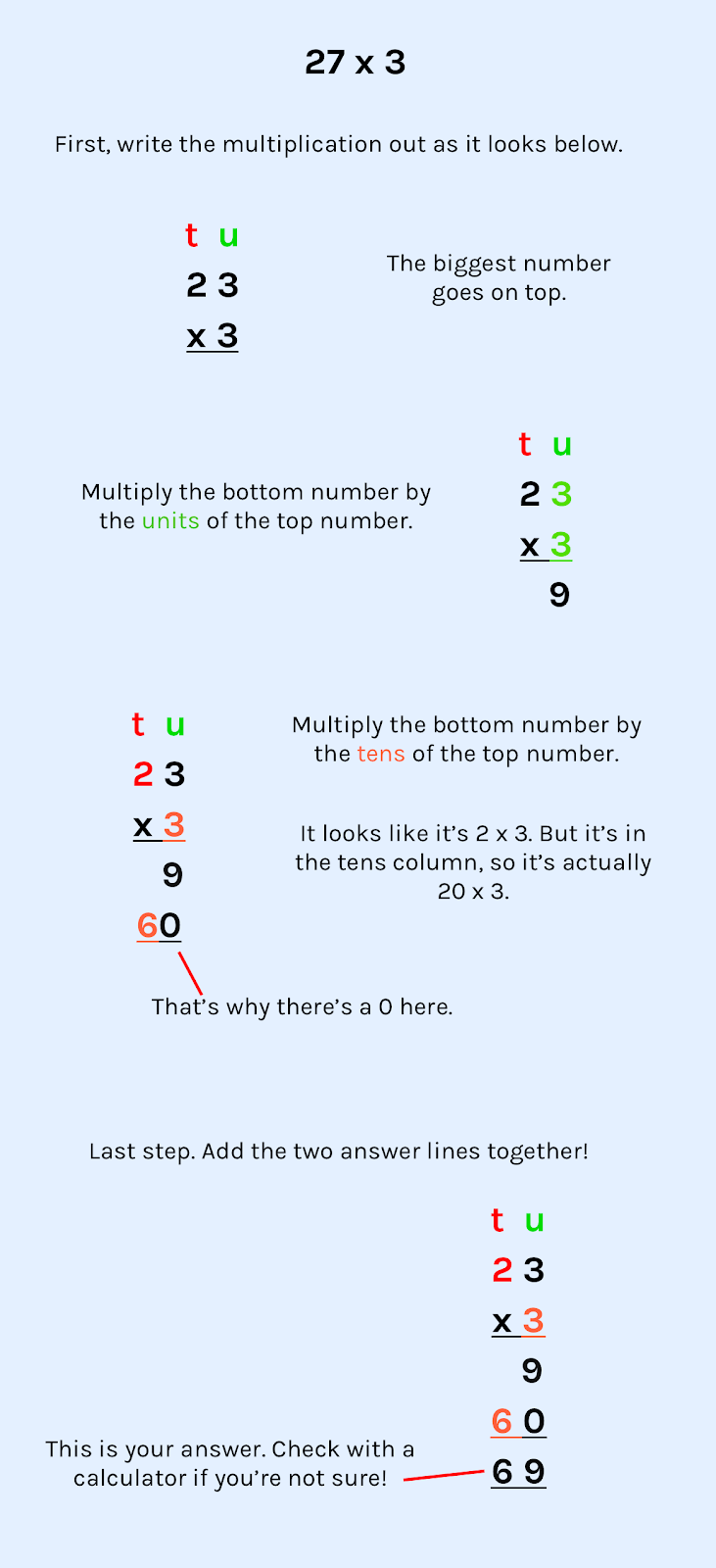
This written method can help children to break down potentially tricky multiplication questions into much smaller and more manageable chunks.
When using this method, if your child makes a mistake at any point in the calculation, you will easily be able to see where it has happened and go back to help them work out how to get to the right answer.
How to teach your child about missing number problems in multiplication
Missing number problems help your child to understand how the relationship between multiplication and division works.
They might sound a little confusing, but they are actually very simple.
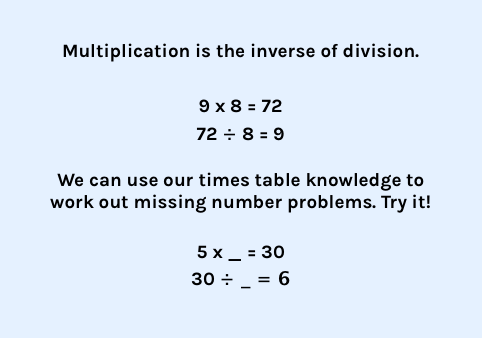
To help your child with missing number problems at home, all you need to do is write up a list of equations (only going up to the 12 multiplication tables), and leave some blank for them to fill in.
See below for some examples:
2 x _ = 8
8 ÷ _ = 4
3 x _ = 21
21 ÷ _ = 7
Fun ways to learn multiplication tables at home with your 4th grader
Speed tables multiplication game!
What’s the game about?
Recalling multiplication tables as quickly as possible, which is a handy thing to be able to do when the exams come around!
How to play:
- Take turns calling out the answers to your multiplication tables as fast as you can. (up to 12s)
- Make sure you time each other.
- How fast can you get through each set of multiplication facts?
- Turn it into a weekly Sunday afternoon competition and keep track of the results with a leaderboard. Who will be the reigning multiplication tables champion?!
Car modeling game
What’s the game about?
Parked cars make great bar models on the go and are a fun and easy way to practice this useful math method!
How to play:
- Find a line of parked cars and count them together.
- How many cars would there be on two streets?
- How about three?
- Go up to the multiplication table you want to practice the most, adding a new street each time to increase the multiplication table.
Scaling windows game
What’s the game about?
Scaling can seem like a scary word to many elementary school kids, but it doesn’t have to be with this game as it can help them bring scaling into the real world!
How to play:
- Count the number of windows on a house you pass by.
- How many windows would the house have if it were five times bigger?
- Try seven times bigger.
- Or half the size?
How you can help to teach your child multiplication tables at home – Introducing Fizz Buzz the game!
This popular classroom game can be easily adapted for home and is a great way to tackle multiplication tables in a fun way!
How to play:
- Choose the multiplication table you would like to practice.
- Take turns with your child, to count from 1 (or you can get the whole family in on this one).
- When you get to a multiple in your chosen multiplication table, you must say “FIZZ!” instead of the number.
- A way you can make it harder is to add an extra rule. If any number contains the same number you chose for the multiplication table, you have to say BUZZ!
Have a look at this written example:
Fizz Buzz for the 3 multiplication table
1, 2, FIZZ, 4, 5, FIZZ, 7, 8, FiZZ, 10, 11, FIZZ, BUZZ
How to learn multiplication in 5th grade
5th grade is important when it comes to building a good foundation for math. Children start to multiply bigger numbers using written methods and decimals come into play.
There’s a focus on learning new methods in math lessons this year, but it’s crucial to keep practicing word problems too.
By the end of 3rd grade, your child should have a good grasp of the multiplication tables (and their division facts) up to 12 x 12. They also should have practiced them throughout 4th grade, so they should be very familiar and comfortable with them in 5th grade.
How you can help your child with standard algorithm multiplication (multidigit numbers)
The standard algorithm is used for bigger numbers. 5th graders will see multiplication equations with 5 or more digits being multiplied by 2 or 3 digits.
There are a few steps involved, but with good multiplication table knowledge and neat presentation, it can be a handy method to know for any budding 5th grade mathematician.
Here is another example of the standard algorithm being used to multiply bigger numbers.

As mentioned, this method does involve quite a few steps, but by doing it in this way, not only will your child be able to visualize the process clearly, but you will be able to spot any mistakes and help guide them to the correct answer.
How to help your child with the multiplication of decimals
At this point, there’s not much new material when it comes to multiplication and learning multiplication tables. Multiplication of decimals is a new concept for students this year and it’s surprisingly simple.
Once you’ve mastered the standard algorithm, you can multiply pretty much any large number.
However, when it comes to decimals, there’s another method that saves time and confusion. Note that this method is a bit of a “trick” for multiplying decimals, so it is very important for students to also develop a strong understanding of the concept of multiplying decimals.
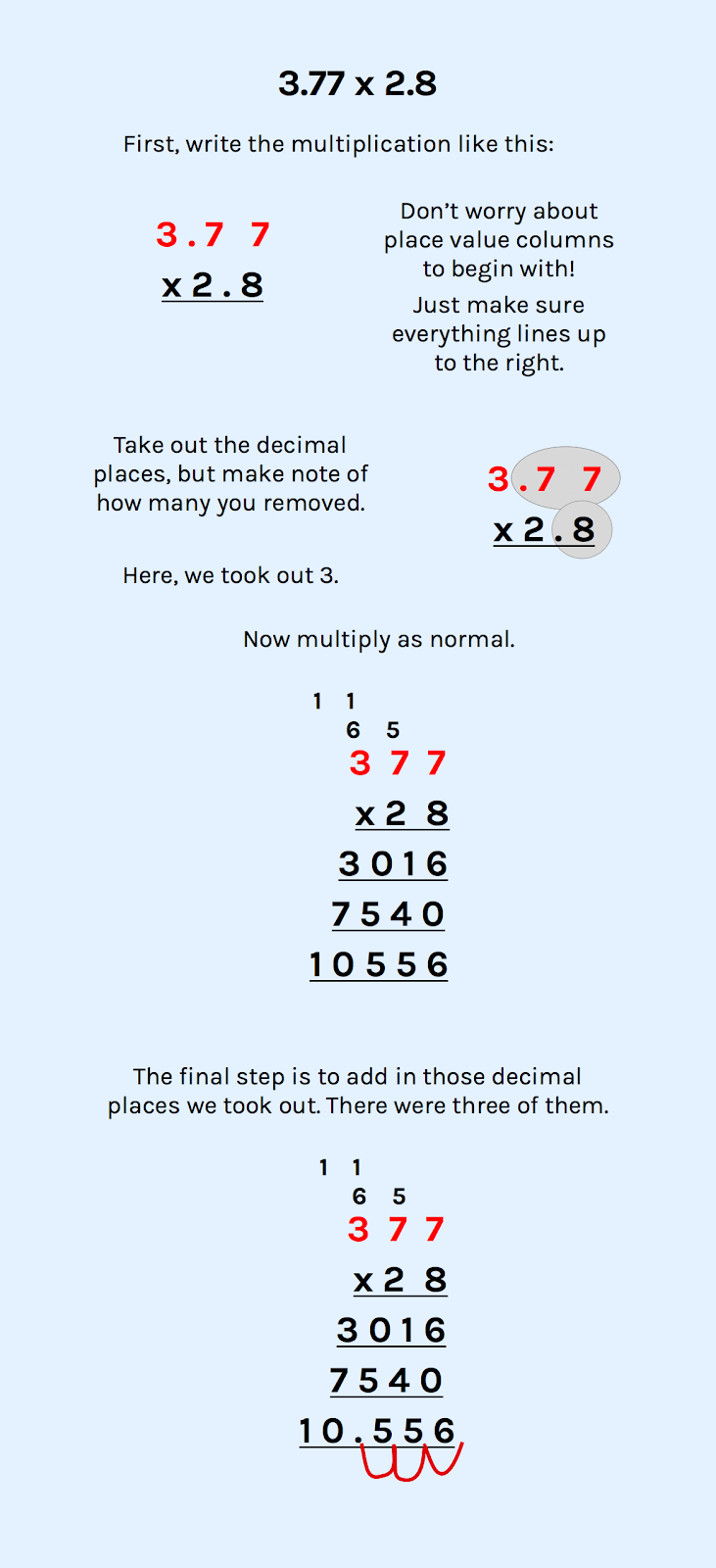
This is a process that may seem a little confusing to your child the first few times they try it, but by practicing it on a regular basis with you, they should soon get the hang of it and have no problems multiplying decimals at school.
This is one of the most intimidating parts of multiplication for many young minds, so if you can take the time to help teach your child multiplication of decimals, you can guarantee that it will be worth it in the long run.
How to help your child with square numbers and exponents
Square numbers and exponents are concepts that may seem simple to adults, but until they are explained to elementary school students they can seem a bit baffling!
As you know, a square number simply means that you multiply a number by itself, and it can be written out as a multiplication equation or as an exponent (a superscript 2,) like this:
2 x 2 = 2²
By addressing the existence of square numbers early on in 5th grade and helping your child to understand what they are and how they work, you can prevent confusion from reigning further down the line should they see them for the first time.
Spend some time writing out and going through all of the square numbers up to 12 x 12 with your child – as well as helping them to get to grips with square numbers, this exercise can also help your child practice their multiplication tables at home!
Make sure your child is comfortable with reasoning and problem solving multiplication questions
In 5th grade, reasoning and problem-solving skills become much more important, and this means that you should encourage your child to practice them as often as you can.
Get your child to practice using test questions often and come up with your own process for working through them. What works will be different for every child, but here’s an example of how you could tackle a tricky word problem:
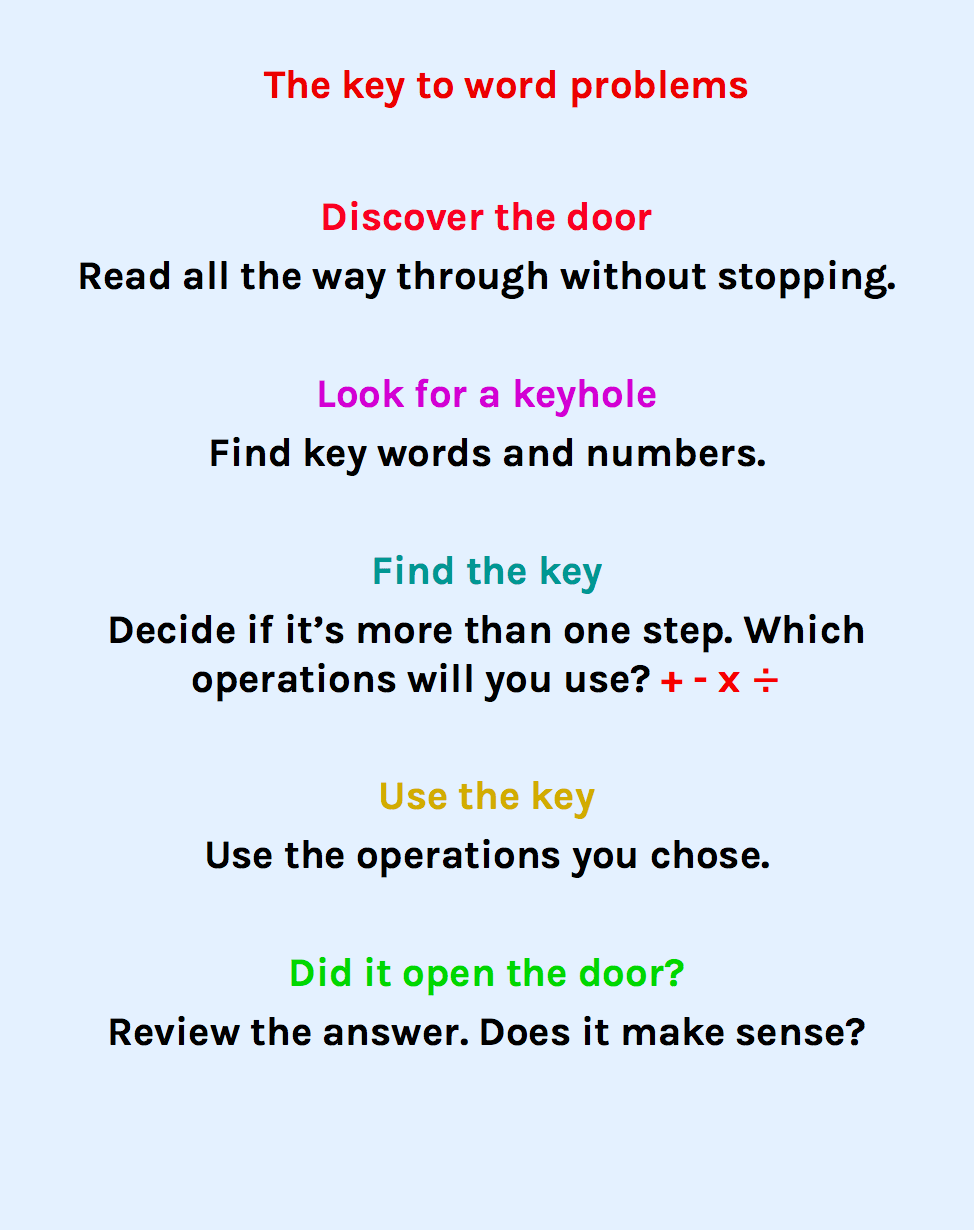
Vocabulary is also important for word problems, so ensure your child goes over mathematical vocabulary often to make them much easier to access.
Fun ways to practice multiplication and multiplication tables at home in 5th grade
While it might seem like there’s no time for fun in 5th grade, it’s actually very important to make sure your child feels good about math.
Nerves on the day of the exam can be detrimental, so make sure any math practice at home is light-touch and light-hearted.
Money multiplication
Practice multiplying decimals using money. You don’t have to shell out extra pocket money to do this – you can get your child to help with things like shopping receipts, bills, and future budgets, too.
These are all great life lessons and your child will enjoy the responsibility at an age when they feel like they’re practically grown ups.
Example questions could be:
“I bought two t-shirts that cost $4.56 each. Can you tell me how much the total amount should be on the receipt?”
“We bought 4 meals from the restaurant with a special offer, so they cost $10.50 each. How much should the total be?
“Every month we spend $31.42 on our water bill. How much will it cost us over the year?”
There are of course a huge number of questions you could ask, but these are just a source of inspiration!
Help your child to open a savings account
Okay, so this might not seem like the most appealing thing to your average 10-year-old, but they will definitely thank you in the long-run (and it’s a great chance to squeeze in some multiplication at home.)
Get your child to open a young savers account and work out how much interest they’ll make each year.
What could they buy if they left it in there for five years? How about ten years?
Let the bank staff know that you’re trying to help your child improve their multiplication skills, and assuming you get a friendly member of staff, they’ll get a real life lesson in why math is important.
Take your child on a trip to the sales
Get to the shops and ask your child to mentally work out any discounts they see.
Knowing how to mentally work out a 20% or 50% discount is challenging, but it makes use of key skills that will benefit every area of elementary math.
Plus, if you make this a trip to the toy shop you can combine work and reward!
Key vocabulary for 3rd, 4th, and 5th grade multiplication
Prime number: Any positive whole number bigger than 1 that can only be divided by 1 or itself.
Composite number: Any positive whole number that isn’t a prime number.
Square number: A number multiplied by itself, like 2 x 2.
Cubed number: A number multiplied by itself and then multiplied by itself again, like 2 x 2 x 2.
Factor: Any number that you multiply by another number.
Common factors: Two or more numbers that can be used to make the same product (answer).
Multiple: Multiples are the many different answers you could get if you multiplied your number by another number.
Common multiple: When the same number happens in different multiplication tables, we call it a common multiple.
How to help your child identify common factors and common multiples
There’s a difference between factors, multiples and products. But with so much new vocabulary flying about, many students mix them up. Luckily though, with a bit of practice, you can help your child master their multiplication vocabulary!
What are factors?
Factors are the numbers that you multiply together.
The answer to this is called the product.
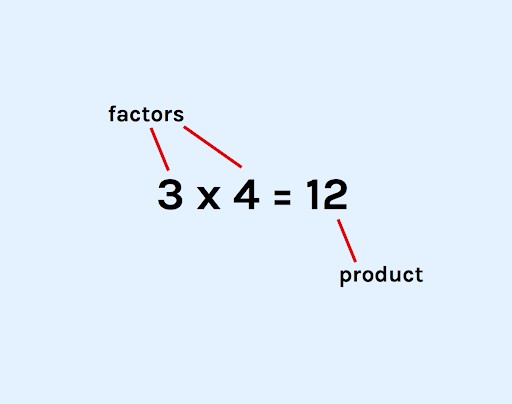
If you have two different products (or answers), but they have a factor in common, we call it a common factor.
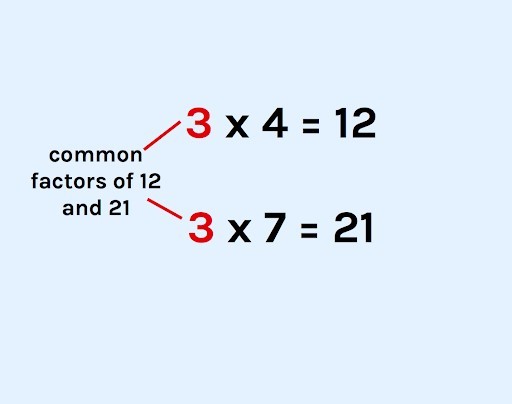
To help your child understand this at home, you can practice alongside them and take turns writing out simple multiplication problems for each other, and then label each part of the problem.
This activity might be simple, but it will prove to be a good test for both your child and you!
What are multiples?
Multiples are the many different answers you could get if you multiplied your number by another number. They make up the multiplication tables. When the same number happens in different multiplication tables, we call it a common multiple.
How to practice finding common factors and multiples with your child at home
Finding common factors can be made simple by using a large number line.
How to:
- Use a number line that goes up to 144, or make your own out of blank sheets of paper.
- Color code the numbers 1 to 12 with a dot under each one.
- Now use each color to label multiples of these numbers.
- For example, if you put a blue dot under the number 2, you’d also put a blue dot under every other number in the 2 multiplication table.
- Use the number line to work out which numbers have factors in common by seeing which numbers share the same color dots. These are common factors.
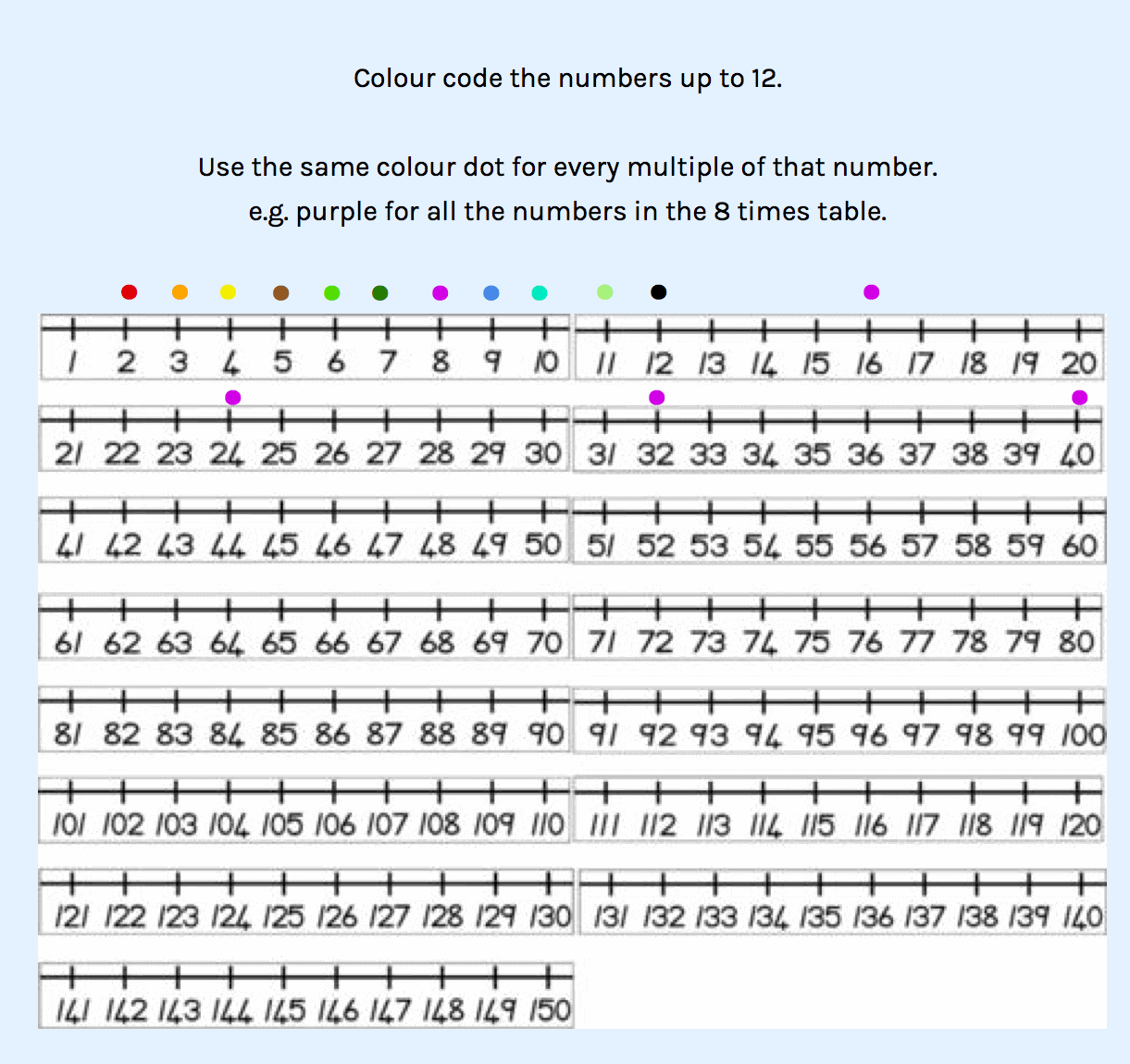
Finding prime numbers
Look at your number line. You’ll notice that some numbers are only in the 1 multiplication table. These are prime numbers. They can only be divided by 1 and themselves. Circle the prime numbers on your number line.
Any positive number that isn’t a prime number is called a composite number.
Do you have students who need extra support in math?
Skye—our AI math tutor built by experienced teachers—provides students with personalized one-on-one, spoken instruction that helps them master concepts, close skill gaps, and gain confidence.
Since 2013, we’ve delivered over 2 million hours of math lessons to more than 170,000 students, guiding them toward higher math achievement.
Discover how our AI math tutoring can boost student success, or see how our math programs can support your school’s goals:
– 3rd grade tutoring
– 4th grade tutoring
– 5th grade tutoring
– 6th grade tutoring
– 7th grade tutoring
– 8th grade tutoring
The content in this article was originally written by primary school teacher Sophie Bartlett and has since been revised and adapted for US schools by elementary math teacher Katie Keeton.
